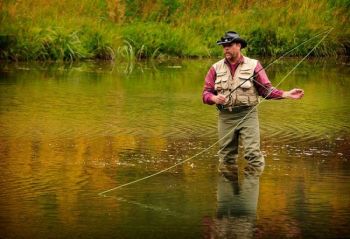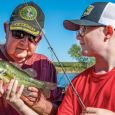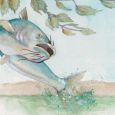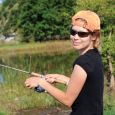The Gift of South Dakota
Subscriptions to South Dakota Magazine make great gifts!
Subscribe today — 1 year (6 issues) is just $29!
Fly-fishing in the Black Hills
Sep 11, 2013
On our first morning of fishing the outlet basin below Pactola Dam, Bill landed his first big brown trout, let him go, and pointed to the sky. "Look there."
I squinted upward. Spiraling high above was a bird of enormous wingspan. "What is it?"
"Osprey."
"You sure? A fish hawk?"
Bill nodded, then waved his hand toward the top of a high-line tower a hundred yards away, where a collection of sticks had been fashioned into a large nest. We'd seen such nests before, along with the birds that built them. Last Chance run on Henry's Fork in Idaho had plenty of ospreys, distinctive white markings bright in the sun, soaring high, circling, then folding their wings and plunging like meteors into the water, emerging in seconds with their catch firm in their talons and flapping off, their trout streamlined nose first to carry back to their nest. But in the Black Hills?
"Have you ever seen them here before?" I asked.
"Never," Bill said. "But we haven't done the Hills thoroughly in quite a few years." It was, I thought, a significant admission. Bill Geyer was raised in the Black Hills, in Lead and later in Sturgis, and had been fishing its streams and impoundments since he was old enough to wave a bamboo rod. If he had never seen an osprey at Pactola before, I reckoned it a relatively new experience. Yet there it was. And later we saw another, perched at the tip top of a spruce over the pond below Hanna, watching rising trout with predatory interest.
Seeing ospreys wasn't the only new experience during our two-week sojourn back in 2000 to what had been the earliest fly-fishing ground for both of us. On our 13th early morning jaunt up Spearfish Canyon, we spotted a mountain goat trotting along the road. He was in molt, the white fur hanging in clumps form his back. When he heard our pickup, he wheeled, took a defiant stance in our lane, and glared as though daring us to come closer.
Finally, after a few seconds, the standoff ended. The goat, apparently satisfied that he had called our bluff, turned and trotted casually across the road and into the brush. Bill put the pickup into gear and drove on.
“You ever—?”
“Nope.” Another first.
Then of course there were the big fish. Years ago, when I first wet a line in Rapid Creek below Pactola, I remember catching what was the largest trout I’d yet caught, a heavy-bodied brown that rose to a dry fly in a pool formed where the stream bent against a granite cliff. I think I still have the outline of that fish, proudly traced on butcher paper, somewhere among my memorabilia. My recollection is that it ran something in excess of 14 inches.
I caught larger trout later, of course, but in the Hills that one was then close to what they call on those TV fishing shows “a good fish, nice fish, big fish.” On Henry’s Fork, however, 16-inch trout are considered average. And on the Green River below the dam at Flaming George in Utah, trout in the range of 20 inches are caught regularly. Yet here in the Black Hills, I caught what I count as the largest rainbow I’ve ever taken.
Bill got several good-sized browns the first morning out on the basin. I got only a few hits. The second day, using one of Bill's vintage bamboo rods, I was frustrated by the vagaries of the wind and by my lousy timing on the backcast, which was attuned to my stout old graphite rod. Still, I managed one perfect cast of a pearlescent midge pupa, and watched in awe as a large rainbow that had been taunting me in the clear water near shore all morning swung around, opened his mouth, and snatched the fly.
All right, here is where I am supposed to give an account of the epic fight, how I hung on until my hands bled as the fish peeled off yards and yards of line. Only it didn't happen that way. The bamboo did the fighting for me, giving in when I tried to horse it, providing just enough resistance to keep the fish booked. The rainbow scooted left, then right, then back again left. Then it slid in toward shore, and I, who hate wading, walked right into the water in my plain old boots and socks.
I bent the bamboo rod almost double trying to urge the bull trout to head for my net. It preferred not to, and thrashed about, trying to turn tail. In desperation, I scooped the net, made for fish of more modest proportions, under the trout's head, but when I lifted, more than half of its length dangled out, its tail whipping water drops. At last I abandoned the net and cornered the rainbow between submerged rocks. With slack on the line, the tiny hook just fell out.
Bill didn't exactly have his camera at ready, so there was a touchy interlude, with me holding the trout in the shallows, while Bill ran toward me, fumbling with the lens cap. Then I reached down, grabbed the fish, held it up for the requisite photo, and slipped it back into the water. As it fled, I remembered that I had forgotten to measure it. It was as long as my arm, though, that I knew, and 1 also knew I'd never caught a rainbow bigger. The adrenaline high lasted the rest of the day. The memory will last much longer.
Bill couldn't understand why I didn't seem keen on fishing the basin after that. I'm not sure I can fully explain even now. I'd gotten my big fish. Anything else would be anticlimactic.
Editor's Note: Ron Robinson's fly-fishing tale is excerpted from “These Are the Good Old Days: Fly-fishing in the Black Hills,” a story that originally appeared in our Sept/Oct 2000 issue of South Dakota Magazine. To order a copy or to subscribe, call 800-456-5117.











Comments